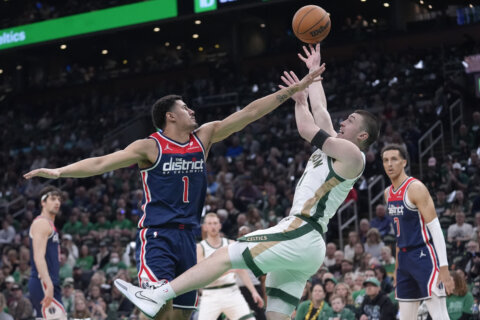How Beal is resurrecting his 3-point shot originally appeared on NBC Sports Washington
WASHINGTON — Earlier this month, Celtics star Jayson Tatum set an NBA record by becoming the youngest player to make 1,000 career threes. The guy he surpassed, ironically, was his childhood friend, Bradley Beal.
That piece of news was a reminder that not long ago Beal was on pace to be one of the greatest shooters in NBA history. It wasn’t a small sample size, either. In three of his first five NBA seasons, he shot 40% from three.
But Beal saw his efficiency start dipping during the 2018-19 season as his role shifted dramatically following injuries to John Wall. Beal went from off-the-ball to more of a primary playmaker, having to shoot more off-the-dribble and with a lot more attention from the defense.
His scoring volume soared, as he led the East in points per game for two consecutive years. But after shooting 39.3% from three over his first six seasons, he shot just 34.5% from deep across four years from 2018-19 through 2021-22. That included a career-low 30% last season.
This year has amounted to somewhat of a breakthrough. He is shooting a career-high field goal percentage (51.5%) and his highest clip from three (37.1%) in five years, since 2017-18.
While injuries have played a part in Beal’s season as a whole, it has been among the most efficient of his career. His effective field goal percentage, which factors in the value of threes, is tied for a career-best (56.6).
Beal offered his theories on why his shooting percentages are up.
“I’m shooting [threes] more, honestly… I’m getting a lot more catch-and-shoots this year, so I would say the shot selection definitely plays a part,” he told NBC Sports Washington.
“Having [Kristaps Porzingis] and [Kyle Kuzma] out there spacing the floor and having guys who are able to be a threat frees me up a lot more than in years past, too. A lot less off the dribble at times, too. A lot of that plays a factor into the percentages.”
Interestingly enough, the numbers counter some of those claims. Beal, in fact, is taking his fewest three-point attempts (4.6/g) since 2014-15. He’s actually taking fewer catch-and-shoot threes per game this season (2.5/g) compared to last year (2.7/g), though it’s a slightly higher percentage of his overall attempts (15% to 14%).
Having Porzingis and Kuzma, who are both averaging career-highs at over 20 points per game, certainly helps. But it’s not leading to more open threes for Beal, according to Second Spectrum. This year he is averaging 2.2 open three-point attempts per game (defender is 4-6 feet away) and 1.7 threes per game deemed wide open (6+ feet away). Last year, he took 2.8 open threes and 1.6 wide open threes on average.
Now, where Beal is correct is that he is taking noticeably fewer shots off-the-dribble. His pull-up attempts this season overall are down to 6.7 per game from 8.1 and from three they have decreased from 2.5 to 2.1.
The biggest difference may simply be that Beal is making the same types of shots he was attempting a year ago. His percentage on catch-and-shoot threes is up from 29.6 to 39.6, on pull-up threes he’s gone from 31% to 34.2% and he’s making 38.1% of his open threes compared to just 25.5% last season.
All of those changes may relate to head coach Wes Unseld Jr.’s theory.
“A lot of feet in the paint, paint threes, in general… They all kind of work in concert. When we move the ball and guys are willing to share it and we space correctly, good things happen for us. He’s a benefactor as well as a facilitator in a lot of those areas,” Unseld Jr. said.
Unseld Jr. loves ‘paint threes,’ a term he uses for when a player drives into the lane and kicks it out to their teammate on the perimeter. Those plays often include a collapse of the defense and they set shooters up with the types of passes they are used to receiving from rebounders in practice. The shooter already has their shoulders squared towards the rim.
Those types of threes, Unseld Jr. believes, have helped the Wizards improve as a team shooting from the outside. They have upped their team three-point percentage from 34.2% last season to 35.9% year-over-year. In the month of February, they rank fifth in three-point percentage (39.4%) and 13th in threes made (12.6).
Personnel is probably a big part of that, as Beal mentioned. Porzingis, in particular, likely makes a substantial difference as a 7-foot-3 center knocking down an above league average 37.6% from deep on 5.5 attempts per game.
An underrated addition may also be Monte Morris at point guard. Last season, Beal played primarily alongside Spencer Dinwiddie and efficiency was not a collective strength. Wizards guards were 26th in three-point percentage (33.7) compared to sixth this season (38.2), per NBA.com.
Morris is shooting 40.6% from long range, including 43.8% over his last 35 games. Those numbers are somewhat of a rarity for the Wizards’ starting lineup. In Beal’s 11 seasons, Morris is one of just five Wizards players to shoot 40% or above while starting at least 50 games (Beal, Otto Porter Jr., Trevor Ariza, Martell Webster).
Morris believes he and Beal have developed strong chemistry in their first season playing together.
“Brad is one of the most unselfish guys I’ve played with. He’s not a guy who just wants to shoot the ball every time. He will draw the defense and make the right play every time,” Morris said.
Beal is now able to operate with more space on the floor. Teams can’t leave Morris or Porzingis open beyond the arc. Kuzma doesn’t shoot as high of a percentage as they do, but leads the team with 2.5 made threes per game.
With more offensive help, Beal can be more selective with his shots. All of it is adding up to a big improvement in efficiency for the three-time All-Star.
“I feel like I should shoot more and more. It’s a matter of them just going in, man. I haven’t changed anything mechanical-wise,” Beal said.






